
http://www.iaeme.com/IJMET/index.asp 1492 editor@iaeme.com
International Journal of Mechanical Engineering and Technology (IJMET)
Volume 10, Issue 03, March 2019, pp. 1492–1501, Article ID: IJMET_10_03_151
Available online at http://www.iaeme.com/ijmet/issues.asp?JType=IJMET&VType=10&IType=3
ISSN Print: 0976-6340 and ISSN Online: 0976-6359
© IAEME Publication Scopus Indexed
MODIFICATION THE CHARACTERIZATION
OF EPOXY POLYESTER BLEND BY USING
TITANIUM DIOXIDE FILLER
Abeer adnan abd
Polymer Department, College of Engineering Materials, Babylon University, Iraq
ABSTRACT
Epoxy resin blended with Unsaturated polyester resin and filled with TiO2 filler.
ultrasonic mixing process. TiO2 nanoparticles were used as reinforcement in prepared
by cast molding method with filler volume fractions (0%,1%, 2%, and 3% ). The thermal
conductivity constant, hardness, compression strength, wear, impact strength and DSC
were studied. Compression strength, wear loss, thermal conductivity constant, DSC,
FTIR, UV, atomic force were studied. The experimental results showed that the thermal
conductivity constant decrease, hardness increase with filler content increase .
Titanium dioxide content in epoxy/polyester blend matrix was dispersed and
investigated by using ultrasonic technique .Sample four give the maximum value of
compression strength. The glass transition temperature, melting point and degree of
crystallization decrease by adding titanium dioxide.
Key words: Epoxy unsaturated polyester, TiO2, nanofiller, Mechanical properties,
thermal stability, polymer blend
Cite this Article: Abeer Adnan Abd, Modification the Characterization of Epoxy
Polyester Blend By Using Titanium Dioxide Filler, International Journal of
Mechanical Engineering and Technology 10(3), 2019, pp. 1492–1501.
http://www.iaeme.com/IJMET/issues.asp?JType=IJMET&VType=10&IType=3
1. INTRODUCTION
One of the ways Nano science has advanced Polymer composites industries of high-
performance for automotive and aircraft applications serving many properties, such as tensile
strength and modulus of elasticity, and thermal stability. With the advent and application of
nanotechnology .[1,2]
Epoxy resin are the widely used materials as a matrix, disc brake, high performance
adhesive joints, automobile industry , paints manufacturing, heat resistance coating [3]. It
displays low reduction as well as its adhesion ability to a variety of substrate materials, high
corrosion and chemical resistance [4].
Epoxy cured by adding hardener like ethylene triamine . [5,6].The research works carried
out to develop the thermal and mechanical properties of epoxy resin by blended with polyester
and the use nanofillers reinforcement.[7,8] Between the most investigated metal-oxide, the

Abeer Adnan Abd
http://www.iaeme.com/IJMET/index.asp 1493 editor@iaeme.com
Titanium dioxide is possibly the most interesting because of the combination of its exceptional
properties such photo catalytic , low cost, non-toxicity and high chemical stability. Titanium
dioxide industries such as aerospace, sports, paints due to high hardness and corrosion
resistance and thermal stabilities and cosmetics( UV protection in sunscreens).[9,10]
Unsaturated polyester have higher impact resistance than epoxy , low cost , good service
properties , thermal stability and weather resistance. Hence these resins are used in number of
applications like insulation coatings, fiber reinforced plastics (FRP) products, bulk molding
compounds, and frictional material matrix.[11,12,13]
The polymer blending reduce the cost-performance balance and tailoring, modifying resin’s
performance, improving specific properties, toughness, solvent resistance .[14-16]
2. THE AIM OF THE WORK:
The main goal of the work was to investigate the blended matrix properties of miscible
epoxy/polyester blends by adding TiO2 filler to enhance mechanical and thermal properties. For
this purpose a blend of epoxy/polyester (85/15 %w/w) polymers were prepared as a function of
nanocomposites in different weight ratios such as 0%, 1%, 2%, and 3%. The final objective of
this study is to identify a suitable nanocomposites which offers low cost, high toughness
material, used in high temperature applications which can be applied in making light weight
components for automobile parts, transportation systems, and friction materials matrix in disk
brake.
3. MATERIALS AND METHODS
In this study were Epoxy with the resin-hardener ratio as 100:10 and Unsaturated Polyester with
2% cobalt naphthanate as accelerator, 2% Methyl ethyl ketone peroxide (MEKP) as catalyst in
10% aniline solution as promoter, in the ratio of the resin/ accelerator catalyst/
promoter:100/2/2/2. In addition titanium dioxide nanofiller with average particle size
(D50:.507) µm.
4. FABRICATION OF BLENDED NANOCOMPOSITES:
Epoxy/polyester (i.e. 85/15 %w/w ratio) were mixed together by intensive mixer for about one
hour at ambient temperature conditions then hardener/accelerator/catalyst/promoter
(100:10/2/2/2) parts by weight was added to the modified epoxy/polyester mixture.
Titanium dioxide was added to the blend at different weight ratios (0,1,2,3,4)%. then
ultrasonic assisted dispersion of titanium dioxide (TiO2) nanoparticles. The samples prepared
by using glass mold. Glass mold covered with nylon adhering film to enable easy removal of
the sample. The dimensions according to ASTM standard. Another cylindrical mold used to
mold the compression samples. The nanocomposites blend was molded over the glass mold.
Brush and roller was used to impregnate the nanocomposites to ensure complete curing the
blended nanocomposites samples were post cured at 70ºC for one hour.
5. RESULT AND DISCUSSION
Mechanical Properties
Hardness Tests
The hardness increases with Filler content increase as shown in figure (2). The filler (TiO2) has
more hardness than polymer blend. The hardness increase because the density increased.
Particles shape are irregular including pentagonal, rectangular shape and greater surface area,
better aspect ratio , and higher loading therefore the surface area increase .

Modification the Characterization of Epoxy Polyester Blend By Using Titanium Dioxide Filler
http://www.iaeme.com/IJMET/index.asp 1494 editor@iaeme.com
Figure 1 Represent LBZA average particle size
Figure 1 Represented hardness verses filler content
Figure 2 Represent weight loss versus time for sample one
Wear Tests Results and Discussions
Figure (3) displays the wear lost as a function of the time with (4 N) load of specimen (1). The
wear rate increase when the load capacity increase led to increase the temperature of the surface
of the sample .When the wear time increased the friction force is increased That’s led to convert
the friction work to heat energy thus the wear lost increase due to fatigue cracks led to remove
the thermoset material by brittle fracture . Epoxy materials gets removed in the form of fine
wear debris caused by brittle fracture of the resin .
62
64
66
68
70
72
74
76
0 0.5 1 1.5 2 2.5 3 3.5
shore hardness
filler content
0
0.0001
0.0002
0.0003
0.0004
0.0005
0.0006
010 20 30 40
∆w (g)
Time

Abeer Adnan Abd
http://www.iaeme.com/IJMET/index.asp 1495 editor@iaeme.com
Figure 3 Represent weight loss versus time for sample two
Figure (4) shows the wear loss of the blend of epoxy and polyester of sample (2) . The wear
lost increase with time and reach the steady state that is due to increase the ductility of material
by adding polyester and the wear debris decrease.
Figure 4 Represent weight loss versus time for sample three
Figure 5 Represent weight loss versus time for sample four
0
0.2
0.4
0.6
0.8
1
1.2
010 20 30 40
W∆
TIME
BLEND
0
0.00005
0.0001
0.00015
0.0002
0.00025
0.0003
0.00035
0.0004
0.00045
010 20 30 40
w∆
TIME
0
0.0005
0.001
0.0015
0.002
0.0025
0 5 10 15 20 25 30 35
wear loss
time

Modification the Characterization of Epoxy Polyester Blend By Using Titanium Dioxide Filler
http://www.iaeme.com/IJMET/index.asp 1496 editor@iaeme.com
Figure 6 Represent weight loss versus time for sample five
Figure (5) shows the wear loss decrease by adding titanium dioxide at ratio (1%) of sample
(3) because filler particles harder than matrix material also it was insulated nanoparticles diffuse
the heat and decrease it , that’s decreasing the cracks initiate by increasing work temperature
by wear (i.e.in brake disk matrix). In some application like disc brake the heat increase during
working to reach by repeating car stops to 400oC that’s led to evaporate oxygen to form titanium
oxide which dissipate the heat generated during friction. Its behave as lubricant at high
temperature and the wear get more stable.
Figure (4) shows the wear loss of sample (4) greater than sample (3) because the
agglomeration in nanoparticles .Figure (5) shows the wear loss of sample (5) smaller than
sample (4).
Thermal conductivity
When adding the nanoparticle to the blend the thermal conductivity is reduced according to the
increasing ratio of nanomaterial and it is concluded that the added nanoparticles have good
insulating and thermal stability properties. When the heat increase during service conditions of
frictional materials the samples cracks if the matrix brittle material like epoxy therefore titanium
dioxide ( TiO2 ) is suitable insulated filler to dissipate the heat generated during friction.
Impact Test
Figure 7 Represent weight loss versus time for samples
0
0.00005
0.0001
0.00015
0.0002
0.00025
0.0003
0.00035
010 20 30 40
∆W
TIME
0
10
20
30
40
50
60
70
80
0 1 2 3 4
impact resistant
filler content






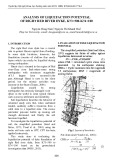


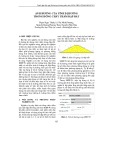
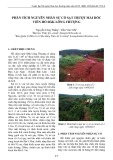



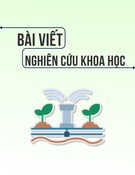


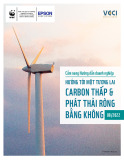







![Ô nhiễm không khí từ nông nghiệp: Thách thức toàn cầu và định hướng hành động [Mới nhất]](https://cdn.tailieu.vn/images/document/thumbnail/2025/20250917/kimphuong1001/135x160/52891758099584.jpg)
